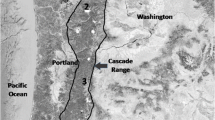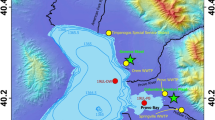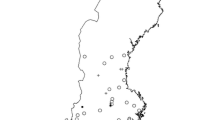Abstract
The acidification of softwater lakes by atmospheric deposition of strong acids has occurred in several regions of the world; however, the rate of acidification of freshwater systems is generally unknown. We have tested the hypothesis that the 210Pb technique can be used to establish the chronologies of sediments in acidified lakes, with the purpose of establishing the rate of change of the chemical and perhaps biological composition of the water. Sediment cores were collected from four lakes near Sudbury, Ontario, Canada, that either were acidic (pH 4.2 to 4.4) or had been acidic, but were recently neutralized by the addition of calcium carbonate/calcium hydroxide. 210Pb flux was measured at five sites per lake. The whole lake fluxes in the Sudbury lakes were significantly lower than those of 11 nonacidic lakes — 250 km to the southeast. Because it is unlikely that lead (Pb) is leached from the sediments, it is hypothesized that acidification results in alteration of the sedimentation mechanism, leading to reduced 210Pb (and stable Pb) retention in acidic lakes. Therefore, the 210Pb method is not suitable for establishing sediment chronologies in recently acidified lakes using existing models.
Access this chapter
Tax calculation will be finalised at checkout
Purchases are for personal use only
Preview
Unable to display preview. Download preview PDF.
Similar content being viewed by others
References
Appleby, P.G. and Oldfield, F., 1983. The assessment of Pb-210 data from sites with varying sediment accumulation rates. Hydrobiologia, 103: 29–35.
Benninger, L.K., 1978. Pb-210 balance in Long Island Sound. Geochim. Cosmochim. Acta, 42: 1165–1174.
Brinkhurst, R.O., Chua, K.E. and Batsoosingh, E., 1969. Modification in sampling procedures as applied to studies on the bacteria and tubificid oligochaetes inhabiting aquatic sediments. J. Fish. Res. Board Can., 26: 2581–2593.
Davis, A.O., Galloway, J.N. and Nordstrom, D.K., 1982. Lake acidification: its effect on lead in the sediment of two Adirondack lakes. Limnol. Oceanogr., 27: 163–167.
Davis, R.B. and Berge, F., 1980. Atmospheric deposition in Norway during the last 300 years as recorded in SNSF lake sediments. II. Diatøm stratigraphy and inferred pH. In: D. Drablds and A. Tollan (Editors), Proc. Int. Conf. Ecol. Impact Acid Precip., Norway, pp. 270–271.
Davis, R.B., Norton, S.A., Hess, C.T. and Brakke, D.F., 1983. Paleolimnological reconstruction of the effects of atmospheric deposition of acids and heavy metals on the chemistry and biology of lakes in New England and Norway. Hydrobiologia, 103: 113–123.
Dillon, P.J., 1982. Mass Balance Models: An Explanation of Observed Chemistry of Lakes Near Sudbury, Ontario. Ontario Ministry of the Environment Study SES 009/82. 147 pp.
Dillon, P.J., 1984. The use of mass balances and mass balance models for quantification of the effects of anthropogenic activities on lakes near Sudbury, Ontario. In: J. Nriagu (Editor), Environmental Impacts of Smelters. Advances in Environmental Science Series, John Wiley & Sons, New York, pp. 283–347.
Dillon, P.J. and Evans, R.D., 1982. Whole-lake lead bur-dens in sediments of lakes in southern Ontario, Canada. Hydrobiologia, 91: 121–130.
Dillon, P.J., Jeffries, D.S., Snyder, W., Reid, R., Yan, N.D., Evans, D., Moss, J. and Scheider, W.A., 1978. Acidic precipitation in south-central Ontario: recent observations. J. Fish. Res. Board Can., 35: 809–815.
Dillon, P.J. and Scheider, W.A., 1984. Modelling the rea- cidification rates of neutralized lakes near Sudbury, Ontario. In: J.L. Schnoor (Editor), Modelling of Total Acid Precipitation Impacts, vol. 9. Acid Precipitation Series, Ann Arbor Science, Ann Arbor, MI, pp. 121–154.
Eakins, J.D. and Morrison, R.I., 1978. A new procedure for the determination of lead-210 in lake and marine sediments. Int. J. Appl. Rad. Isot., 29: 531–536.
Edgington, D.N. and Robbins, J. A., 1976. Records of lead deposition in Lake Michigan sediments since 1800. Environ. Sci. Technol., 10: 266–274.
Evans, H.E., 1982. Gravity Core Sampling in Recent Lake Sediments: The Influence of Core Tube Diameter on Recovering Short Cores, M.Sc. Thesis. Trent University, Peterborough, Ontario, Canada, 96 pp.
Evans, H.E., Smith, P.J. and Dillon, P.J., 1983. Anthropogenic zinc and cadmium burdens in sediments of selected southern Ontario lakes. Can. J. Fish. Aquat. Sci., 40: 570–579.
Evans, H.E., Smith, P.J. and Dillon, P.J., 1983. Anthropogenic zinc and cadmium burdens in sediments of selected southern Ontario lakes. Can. J. Fish. Aquat. Sci., 40: 570–579.
Evans, R.D., 1980. Measurement of Sediment Accumulation and Phosphorus Retention Using Lead-210 Dating, Ph.D. Thesis. McGill University, Montreal, Quebec, Canada, 169 pp.
Evans, R.D. and Rigler, F.H., 1980a. Calculation of total anthropogenic lead in the sediments of a rural Ontario lake. Environ. Sci. Technol., 14: 216–218.
Evans, R.D. and Rigler, EH., 1980b. Measurement of whole lake sediment accumulation and phosphorus retention using lead-210 dating. Can. J. Fish. Aquat. Sci., 37: 817–822.
Flower, R.J. and Battarbee, R.W., 1983. Diatom evidence for recent acidification of two Scottish lochs. Nature, 305: 130–133.
Goldberg, E.D., 1963. Geochronology with lead-210. In: Radioactive Dating. Internatl. Atomic Energy Symposium Proc., 1962, Vienna, pp. 121–131.
Jones, B.F. and Bowser, C.J., 1978. The mineralogy and related chemistry of lake sediments. In: A. Lerman (Editor), Lakes-Chemistry, Geology, Physics. Springer- Verlag, New York, pp. 179–235.
Koide, M., Bruland, K.W. and Goldberg, E.D., 1973. Th-288/Th-232 and Pb-210 geochronologies in marine and lake sediments. Geochim. Cosmochim. Acta, 37: 1171–1187.
Krishnaswami, S., Lai, D., Martin, J. and Meybeck, M., 1971. Geochronology of lake sediments. Earth Planet. Sci. Letts., 11: 407–414.
Nygaard, G., 1956. Ancient and recent flora of diatoms and Chrysophyceae in Lake Grisbo. Folia Limnol. Scand., 8: 32–94.
Renberg, I. and Hellberg, T., 1982. The pH history of lakes in southwestern Sweden, as calculated from the subfossil diatom flora of the sediments. Ambio, 11: 30–33.
Reuther, R., Wright, R.F. and Förstner, U., 1981. Distribution and chemical forms of heavy metals in sediment cores from two Norwegian lakes affected by acid precipitation. In: Proc. Internatl. Symp. Heavy Metals in Environment, Amsterdam.
Robbins, J.A., 1978. Geochemical and geophysical appli-cations of radioactive lead. In: J. Nriagu (Editor), The Biogeochemistry of Lead in the Environment. Elsevier, Amsterdam, pp. 285–294.
Robbins, J. A., 1980. Sediments of Southern Lake Huron: Elemental Composition and Accumulation Rates. EPA-600/3–80–080. Great Lake Research Division, University of Michigan, Ann Arbor, MI, 309 pp.
Robbins, J.A. and Edgington, D.N., 1975. Determination of recent sedimentation rates in Lake Michigan using Pb-210 and Cs-137. Geochim. Cosmochim. Acta, 39: 285–304.
Robbins, J.A., Krezoski, J.R. and Mozley, S.C., 1977. Radioactivity in sediments of the Great Lakes: post– depositional redistribution by deposit-feeding organisms. Earth Planet. Sci. Letts., 36: 325–333.
Schindler, D.W., 1980. Experimental acidification of a whole lake: a test of the oligotrophication hypothesis. In: D. Drabltfs and A. Tollan (Editors), Proc. Int. Conf. Ecol. Impact Acid Precip., Norway, pp. 370–374.
Schindler, D.W., Hesslein, R.H., Wagemann, R. and Broeker, W.S., 1980. Effects of acidification on mobilization of heavy metals and radionuclides from the sediments of a freshwater lake. Can. J. Fish. Aquat. Sci., 37: 373–377.
Sly, P.G., 1983. Sedimentology and geochemistry of recent sediments off the mouth of the Niagara River, Lake Ontario. J. Great Lakes Res., 9: 134–159.
Sly, P.G., 1984. Sedimentology and geochemistry of modern sediments in the Kingston basin of Lake Ontario. J. Great Lakes Res., 10: 358–374.
Tolonen, K. and Jaakkola, T., 1983. History of lake acidification and air pollution studied on sediments in South Finland. Ann. Bot. Fennici, 20: 57–78.
Yan, N.D. and Dillon, P.J., 1984. Experimental neutralization of lakes near Sudbury, Ontario. In: J. Nriagu (Editor), Environmental Impacts of Smelters. Advances in Environmental Science Series, John Wiley & Sons, New York, pp. 417–456.
Yan, N.D. and Lafrance, C., 1984. Responses of acidic and neutralized lakes near Sudbury, Ontario, to nutrient enrichment. In: J. Nriagu (Editor), Environmental Impacts of Smelters. Advances in Environmental Science Series, John Wiley & Sons, New York, pp. 457–521.
Yan, N.D. and Miller, G.E., 1984. Effects of deposition of acids and metals on chemistry and biology of lakes near Sudbury, Ontario. In: J. Nriagu (Editor), Environmental Impacts of Smelters. Advances in Environmental Science Series, John Wiley & Sons, New York, pp. 234–282.
Editor information
Editors and Affiliations
Rights and permissions
Copyright information
© 1986 Springer-Verlag New York Inc.
About this paper
Cite this paper
Dillon, P.J., Scholer, P.J., Evans, H.E. (1986). 210Pb Fluxes in Acidified Lakes. In: Sly, P.G. (eds) Sediments and Water Interactions. Springer, New York, NY. https://doi.org/10.1007/978-1-4612-4932-0_43
Download citation
DOI: https://doi.org/10.1007/978-1-4612-4932-0_43
Publisher Name: Springer, New York, NY
Print ISBN: 978-1-4612-9364-4
Online ISBN: 978-1-4612-4932-0
eBook Packages: Springer Book Archive




